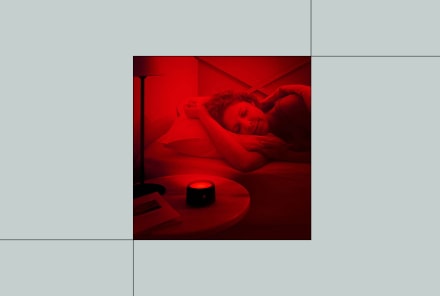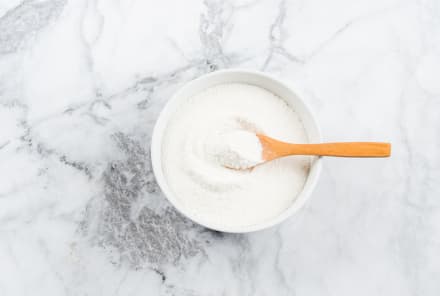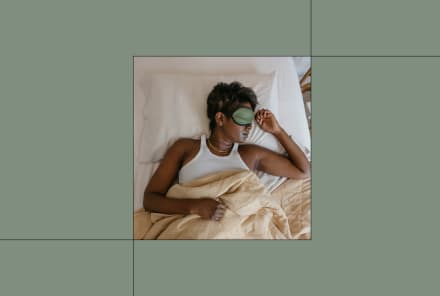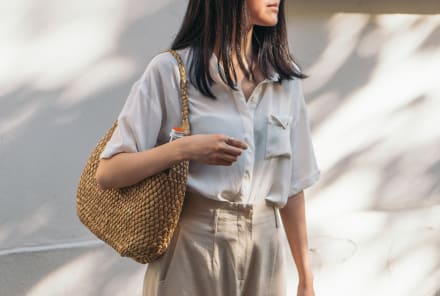Advertisement
13 Of The Best Menstrual Cups To Buy + How To Properly Use Them


If you're thinking about making the switch to menstrual cups, first of all: Congrats! Compared to tampons or pads, menstrual cups can be more eco-friendly, wallet-friendly, and in some cases, vagina-friendly. Though it may take a bit of trial and error to find the right one based on your unique vagina and purchasing priorities, once you do find it, we doubt you'll look back.
How to use a menstrual cup.
If you're planning on using a menstrual cup, always read the instructions listed on your product's packaging. Most often, there will be a detailed step-by-step guide for inserting and removing your cup. That said, here are some general guidelines to help familiarize you with the process (pro tip: try this out when you're not on your period).
Inserting your cup:
1. Wash your cup (and your hands).
The first step is to disinfect your cup, following the instructions listed on the package.
Menstrual cups (or anything that's going to be inserted into the vagina, for that matter) should be thoroughly cleaned to avoid disrupting the balance in your vaginal pH. "The vagina is home for a myriad of bacteria and fungi to keep it healthy, but you throw that organism out of balance, and it leads to infections such as UTI," board-certified OB/GYN Anna Cabeca, D.O., previously told mbg.
Once your cup is clean, it's important to wash your hands for the same reason.
2. Figure out how to fold it.
After you've cleaned your cup and your hands, there are a few ways you can manipulate the shape to insert it comfortably into your vagina. Menstrual cup brand Saalt recommends the C-fold, the punch-down fold, and the 7-fold (all of which they demonstrate here).
3. Insert it.
Once you've figured out the right fold for you, it's time to insert your cup. Unlike using a tampon, you're going to have to get intimate with your vagina in order to insert your menstrual cup. It may take you a few tries to figure it out—that's totally normal.
You can insert it while standing with one leg raised and resting on the toilet or tub, squatting, or sitting. When you're ready to insert: "Slide it up and back at an angle (toward your tailbone, not straight upward), until the body of the cup is completely inside," Saalt instructs on their website.
Once it's inside, make sure the cup has popped open so that it can collect the blood. If the base of the cup is round, then you're set. If you feel dents or folds, however, try grabbing the base of the cup and rotating it until it fully opens. This "seals" your cup to prevent unwanted leakage.
Removing your cup:
After 12 hours have passed, or if you believe it's full, it's time to remove your cup. "There is a learning curve with the cup, so maybe the first few times try it out at home when you don't have to be anywhere," suggests pelvic health physical therapist Marcy Crouch, P.T., DPT, CLT, WCS. But regardless of where you are, here are her tips for easy removal:
- Try a squatting position. "Squatting is a great position for pelvic floor muscle relaxation, and that can help bring the cup down."
- Find the stem. The stem is there to help you locate the cup, but don't pull on it. You need to break the seal first.
- Break the seal. "Gently grab the bottom of the cup, pinch it to break the seal (or even run your finger up and over the rim to break the seal)."
- Pull it out. After you've broken the seal, relax. "Breathe slowly and deeply, and gently bear down (like you are having a bowel movement), while pulling it out."
What are the benefits of using menstrual cups?
There are plenty of benefits to using menstrual cups, one of them being they're an eco-friendly alternative to pads and tampons. "You use one cup per menstrual cycle, unlike pads or tampons, where you use multiple ones on multiple days and each month over and over again," Cabeca says.
Since they're reusable, menstrual cups are also more cost-effective than other menstruation products. "In the long run, the cost is minimal compared to tampons and pads if you have to go through a few," Crouch says.
From a comfort standpoint, Cabeca adds that menstrual cups are easy to use, safe, and don't create irritation in the vaginal tissue. "There's less risk of toxic absorption, like with tampons and pads, for example."
How to pick the right menstrual cup for you.
When looking for a menstrual cup, functional OB/GYN Wendie Trubow, M.D., MBA, notes "Be prepared to try a few since they're all slightly different. Think of it like dating—you're seeing what you mesh best with."
The best menstrual cups for beginners.
If you've never used a menstrual cup before, it's helpful to read the descriptions and sizing guides of various cups to find one best tailored to your body.
"You can find your cervix in your vagina with your finger (it feels like the tip of a nose) to determine if you have a low or high cervix, and that can help determine what size cup to use," Crouch says. If you have a high cervix, you'll want a longer menstrual cup, and if you have a low cervix, you'll want one shorter in length. "You can always trim the stem if you find it sticks out too much," she adds.
It's also worth noting, "the cervix comes lower in the vagina during ovulation, and then after ovulation it moves back higher, so it can be different heights depending on the time of the month," explains Trubow.
If you're unsure which size is best, either opt for the smaller one to start, or buy a two-pack to try both. "A menstruating person may find that two sizes of cups may be more comfortable depending on where they are in their flow," Crouch says. Think of it like buying a double pack of regular and super tampons.
What are the best menstrual cups for heavy flow?
If you've had a vaginal birth or simply have a heavy flow, you'll benefit from buying a larger size menstrual cup so you're not having to empty it out as frequently.
What are the best menstrual cups for teenagers?
Some brands have cups made specifically for teenagers, so look for that on the packaging. Otherwise buying a smaller cup that is shorter in size would be better suited for someone with a lighter flow.
13 of the best menstrual cups to buy.
There's a lot to consider when buying a menstrual cup. To make it easier for you, we've rounded up a few of the best options, depending on your specific needs. All of the products are made from medical-grade silicone, except for the Hello Cup, which is made from the highest-quality medical-grade TPE (thermoplastic elastomer).
Best overall
Not only is the Saalt menstrual cup cute to look at, but it's also easy to use—even if it's your first time. Reviewer Melissa B. says of using the cup: "I did a lot of research before deciding to get a cup, and it paid off. The instructions were easy to follow for my Saalt cup and made using it for the first time a breeze." Saalt is a one-stop shop for a range of period needs. Their standard cup comes in two different sizes (regular or small), as well as a two-pack, so you can swap based on your flow. They also make a soft silicone version for people with bladder sensitivity, and a teen cup for new menstruators.
Regular size menstrual cup, Saalt ($29)
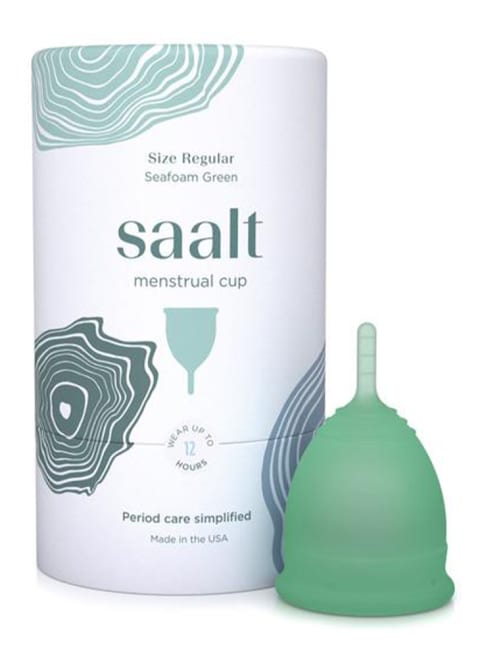
Best for the environment
Though all menstrual cups are more eco-friendly than single-use tampons or pads, the OrganiCup considers the environment in every step of their manufacturing process. It's made from 100% medical-grade silicone, which is "derived from quartz, a type of sand, which is the second most abundant mineral in the Earth's crust and not hazardous to the environment," their website states. It's also shipped in a minimal, plastic-free, recyclable carton and the cup's carrier bag is made from unbleached organic cotton. "l love how environmentally friendly the OrganiCup is," reviewer Hillary says. "It is easy to use and comfortable, and I can wear it for a full day. It's been a great way to eliminate waste, and I actually get excited to use it each month."
Menstrual cup, Organicup ($28)

Best for beginners
The FLEX beginner menstrual cup is perfect for anyone new to this period product. The patented pull tab eliminates one of menstrual cups' trickiest learning curves: removal. While most cups require you to grip the base to break the seal, the pull tab allows it to be removed just like a tampon. Though the tab might look clunky, reviewer Jacquelyn M. writes: "The pullout tab is made of soft, pliable silicone that does not poke or irritate like other cups. I work 12+ hour shifts and cups are perfect; others are uncomfortable and I dreaded removing them due to the pain I experienced." Bonus: This purchase comes with two free menstrual discs so you can have mess-free period sex.
Beginner menstrual cup, FLEX Cup ($35)

Best for light flows
The Lunette model 1 light flow menstrual cup is best for people who would typically need to change their tampon about two to three times per day or even someone who's spotting or nearing the end of their period. Since they are made with a softer medical-grade silicone than the model 2, this Lunette cup is friendly for beginners or young menstruators, as well. "On light days, I go the full 12 hours without emptying. It is such a breath of fresh air to actually be able to forget I'm even on my period," says user Hannah M.
Light flow menstrual cup, Lunette ($40)
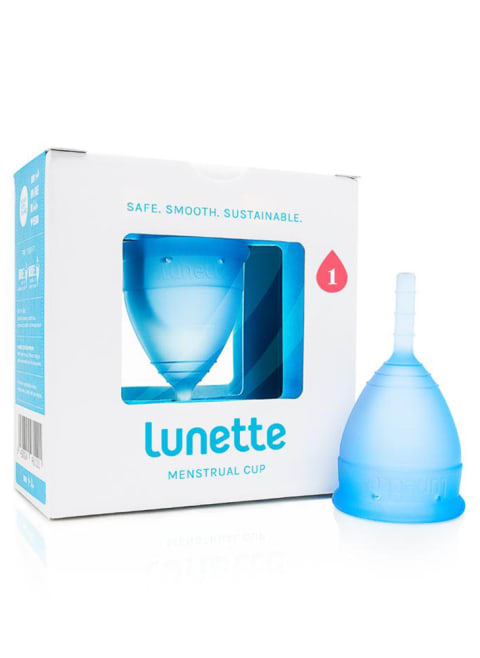
Best for heavy flows
The large menstrual cup from Dutchess is made for people with heavier periods, including anyone who naturally has a heavy flow, a high cervix, or for those who have delivered a child vaginally. One large cup holds about 25 ml of fluid, which is equivalent to about five regular or two super tampons. "My period is usually heavy AF like it's coming directly from the cervix of an angry volcanic goddess who just got mauled by a savage lion... But this has not leaked once. Not even overnight," writes user T. Deleon. "Even with my great rapids heavy flow, I didn't have to empty the cup that often. Maybe every 6 hours."
Large (A) menstrual cup, Dutchess Cup ($10)
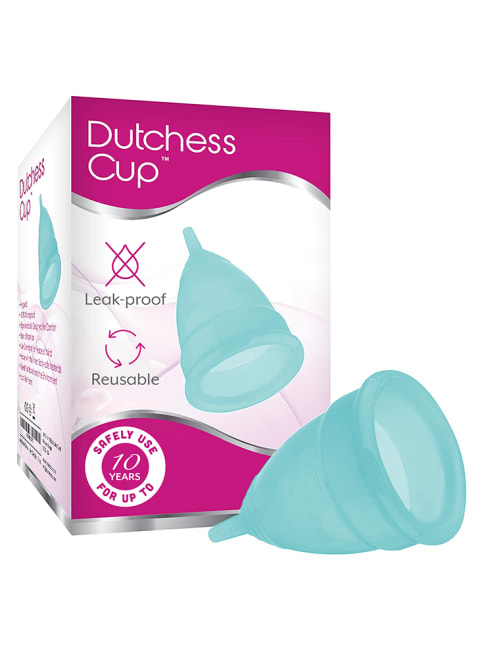
Best for sensitive vaginas
Unlike most softer cups, the Lena sensitive cup still works for people with light or heavy flows. It's made with a smoother medical-grade silicone than their standard cup and is designed for people who experience painful menstrual cramping or bladder or pelvic sensitivity. One user, Ana T., writes, "I've used a menstrual cup for 15 years, starting shortly after my first period. (So let me tell you, I've used my fair share of brands and sizes.) For the past 10 of them, I've suffered from vulvar vestibulitis. Lena's sensitive cup is by far the most comfortable one I've worn. It's flexible enough not to cause pain during insertion, and its shape makes it un-irritating when worn all day."
Sensitive Cup, Lena ($27)
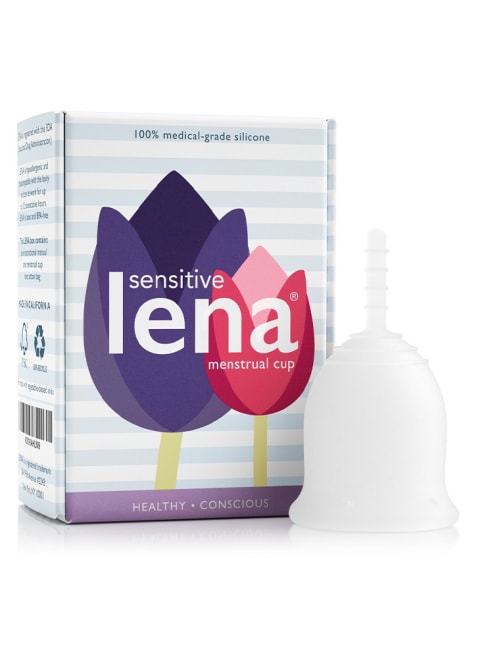
Best for comfort
This menstrual cup from the Honey Pot Company is made from medical-grade silicone, comes in two sizes, and is sold at a decent price point. While those are all great perks, most reviews revere this cup for its comfort level. "This cup is comfortable, and I honestly forget it's in sometimes," writes Phee. "I would recommend this to first-time cup users and longtime users!"
Another reviewer, Grace the Runner, writes, "It is the perfect fix for all of my period needs, very comfortable."
Menstrual cup, The Honey Pot Company ($22)
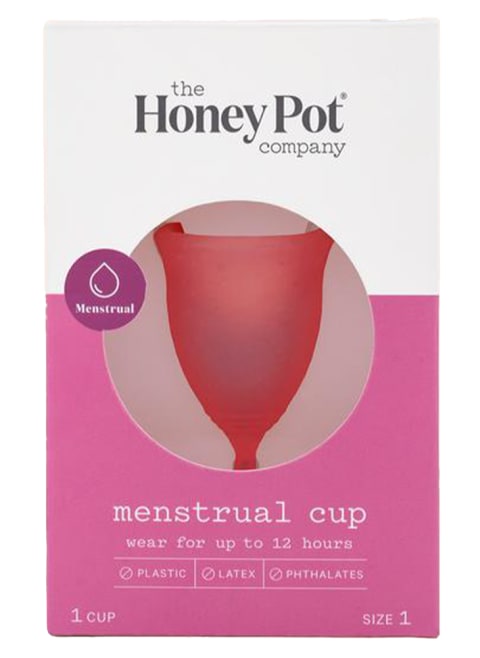
Best budget-friendly option
This clear menstrual cup from JUNE is by far the cheapest option on the market.
JUNE founder Hedi Rappard found relief from her chronic yeast infections after making the switch to menstrual cups. After realizing how pricey they could be, she decided to make the product more accessible by selling them at cost. Enter: the JUNE menstrual cup, which comes in mini, small, and large. "I've been looking into cups for a while now, but they're pretty expensive, and if it doesn't work out, I don't want to waste $40. So when I saw the JUNE cup, I thought let's test it. Once you get the hang of it, it's very easy to insert, and you don't have to think about it all day," says reviewer Jessica.
Mini/Small/Large menstrual cup, JUNE ($6)
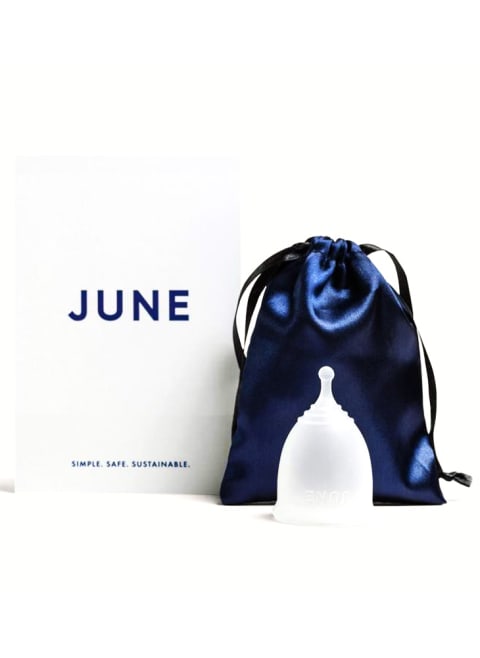
Best storage
Almost as important as cleaning the cup is cleaning the case that it's stored in. This case (also made from medical-grade silicone) keeps your LOLA cup clean from debris or dust that could mess with the balance of your vaginal microbiome. "I love this cup and its case. It's easy to use, store, clean, and it's incredibly comfortable," user Senait Y. says.
Menstrual cup and case, LOLA ($34)
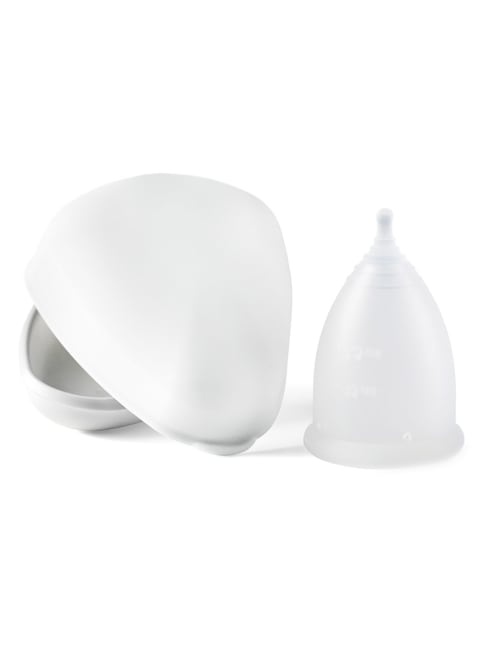
Best for low cervix
Though most brands make "small" cups, which can technically accommodate someone with a low cervix, the stems can be irritating and long. This Hello Cup menstrual cup (designed by a nurse) is shorter and made without a stem to ensure comfort. Don't fret; the base is made thicker so it's still easily graspable for removal. "If you have a low cervix, this cup is a total game-changer," says user Hannah. "I've been a fan of the original hello cup for a while because the toggle is the only stem that doesn't irritate me. But now with the toggle-less cup, it's a dream come true!"
Low Cervix Cup, Hello Cup ($33)
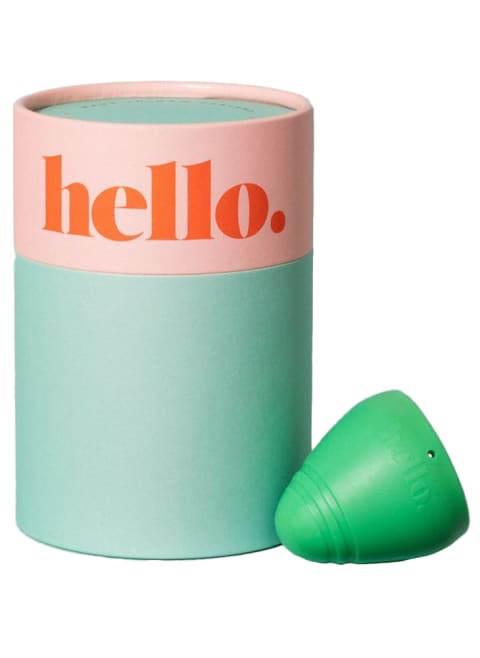
Best for high cervix
For someone with a higher cervix, the stem might not be an issue, but shape and length certainly will be. This menstrual cup from DivaCup is more oblong and cylindrical than bell-shaped, which helps it reach the cervix to prevent leaking—while still extending wide enough to remove, without fear of it getting lost. "I found Model 2 a perfect fit as I've had a child and also find my cervix to sit rather high," user Sara S. writes on Amazon. "I figured there would be a learning curve, but it was really easy to get in and out."
Model 2 menstrual cup, DivaCup ($40)
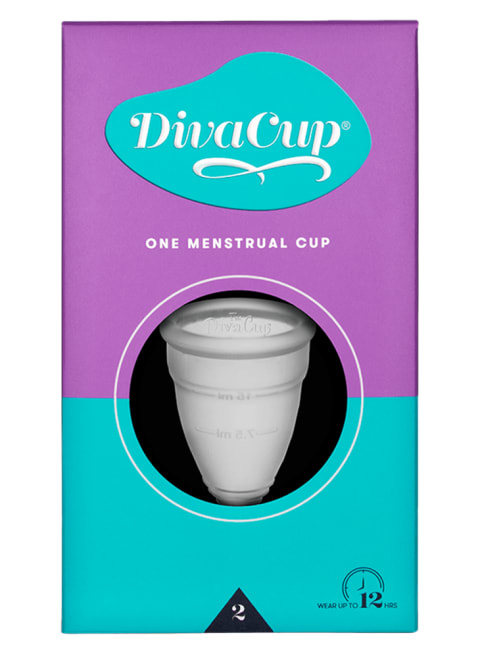
Best for teenagers
The mini menstrual cup is best for young menstruators, beginner cup users, or anyone with a light flow. "I was nervous about how a menstrual cup would fit because a lot of them looked way too big," writes user Lacy. "After trying this cup, I absolutely love it! The size is great, and I can't feel it at all. I would recommend this cup for anyone looking for a smaller menstrual cup."
Mini menstrual cup, UltuCup ($40)

Best for traveling
This collapsible Lily Cup from Intimina is made for the woman on-the-go. Think of it like the emergency tampon you typically keep in your purse pocket, only reusable. Not only can you take this discreet menstrual cup with you wherever you go, but it's also effective against light or medium periods for up to eight hours. "I've been using it for about two years now and have almost stopped noticing my period—that's how convenient the cup has made my life... It's especially convenient for travel days," says Ellie ST.
Lily Cup Compact, Intimina ($30)
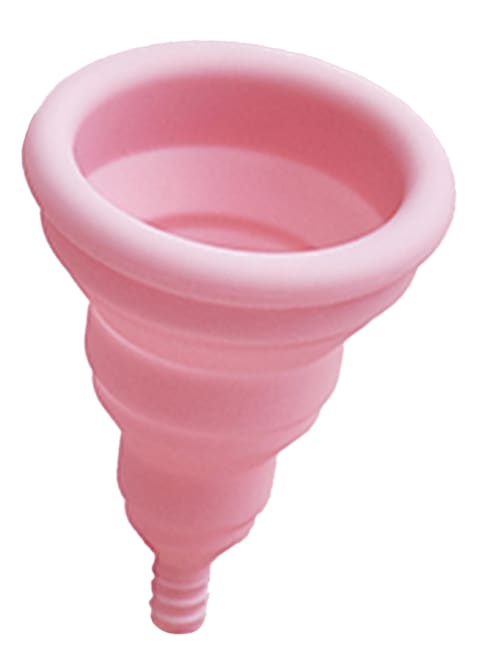
Whether you're just starting to have periods or have had them for many years, there is a cup for you. Don't be scared to try a few to find the best fit.
Editor's Note (June 24, 2022): This article was originally published on May 28, 20201. A previous version of this article identified sources as Marcy Crouch, P.T., DPT, WCS, and Wendie Trubow, M.D. We have since updated this to reflect their additional titles
Watch Next
Enjoy some of our favorite clips from classes
Enjoy some of our favorite clips from classes
What Is Meditation?
Mindfulness/Spirituality | Light Watkins
Box Breathing
Mindfulness/Spirituality | Gwen Dittmar
What Breathwork Can Address
Mindfulness/Spirituality | Gwen Dittmar
The 8 Limbs of Yoga - What is Asana?
Yoga | Caley Alyssa
Two Standing Postures to Open Up Tight Hips
Yoga | Caley Alyssa
How Plants Can Optimize Athletic Performance
Nutrition | Rich Roll
What to Eat Before a Workout
Nutrition | Rich Roll
How Ayurveda Helps Us Navigate Modern Life
Nutrition | Sahara Rose
Messages About Love & Relationships
Love & Relationships | Esther Perel
Love Languages
Love & Relationships | Esther Perel

